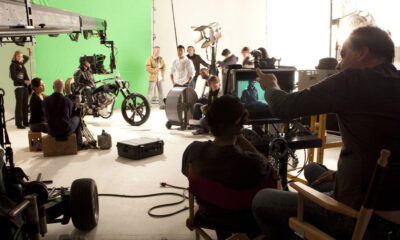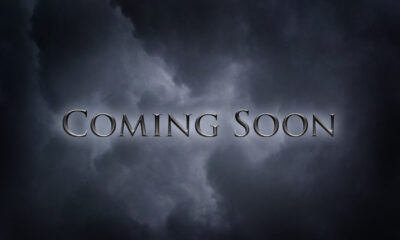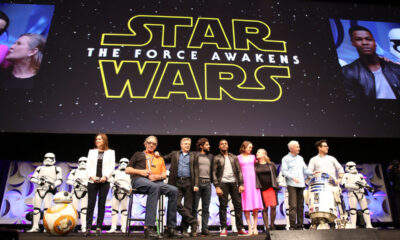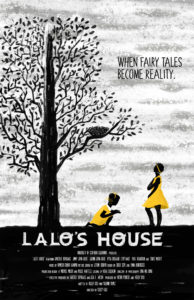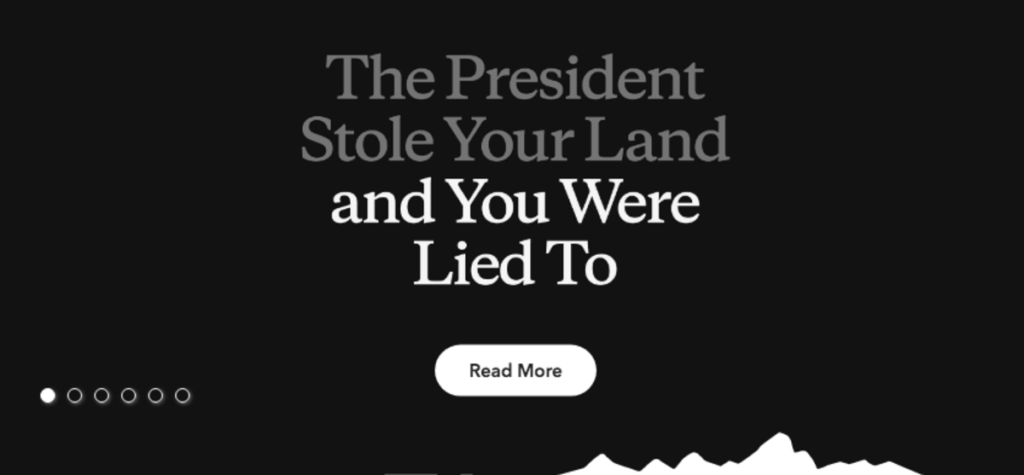Academia
How Gender Mobility in Rango Implies the Fall of the West (and the Western Genre)
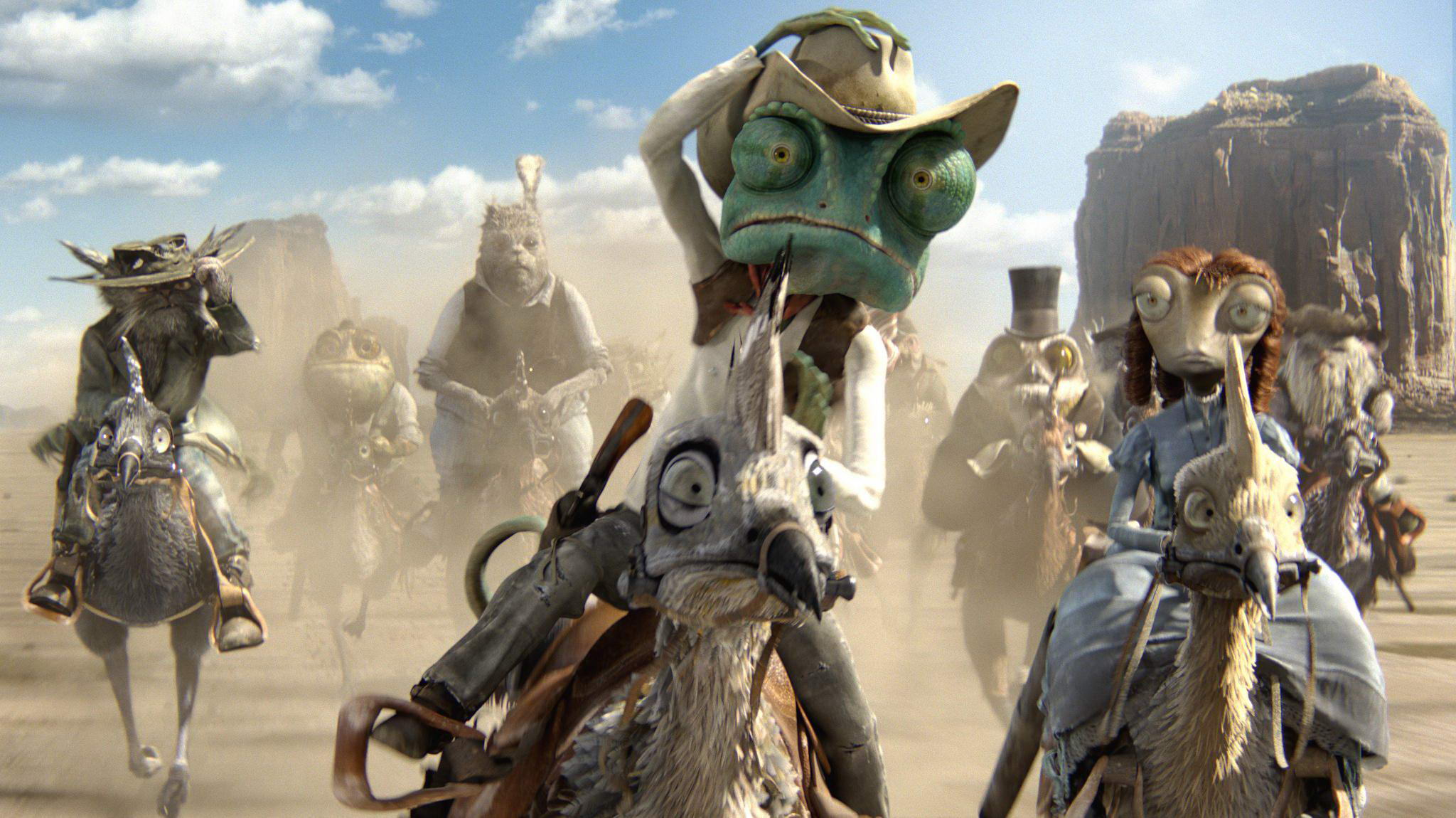
Rango (2011) is an animated Western film about a chameleon that stumbles upon the town of Dirt, where he creates a false identity fulfilling his desires to be an actor. The chameleon protagonist whose real name – Lars – is hardly mentioned, falsely identifies as Rango, the toughest lizard of the west. Rango quickly acts his way into becoming Dirt’s new sheriff, as well as their only hope in preserving their town from deteriorating in the rough climate of the desert. Throughout this essay, I demonstrate how Rango identifies with the traditional Western genre through William J. Devlin’s, ‘The Decline of Ethics and the West(ern).’ I claim that this demonstration is challenged, and almost parodied, through the gender mobility seen in some of the main characters within the film as discussed in Jennifer Peterson’s, ‘The Competing Tunes of Johnny Guitar: Liberalism, Sexuality, Masquerade.’ Finally, by placing Rango in conversation with J. Hoberman’s ‘How the Western Was Lost,’ I claim that Rango’s undertones of gender mobility imply the dying of the genre itself through the loss of both the ideal male Western hero and the archetypes that structure the west.
Traditional Western films make it easy for their audience to discern good from evil, and follow a basic structure where in the end the hero almost always prevails. Devlin writes, “…the moral poles of good and bad in the western cinematic society are very clearly defined,” which in turn “helps to provide stability and order to the western film” (221-222). We see many of these traditional qualities throughout Rango, insofar as the plot follows these central features that make up a Western. Rango is centered on a town whose name, Dirt, resembles not only the environmental aspects, but also the obvious harsh conditions of the fictional town. Even the town’s people represented in the film mimic the traditional Western in that they are “represented as good, innocent families seeking a better life for themselves through hard work and honest living” (Devlin, 226). Dirt is in need of a hero to preserve the water and keep the town from disappearing, and Rango steps in to fill this need. Rango – although arbitrarily constructed by Lars – manages to rescue the town after a series of lucky standoffs against the ‘bad guys,’ most notably against Rattlesnake Jake whose death marks the end of the town’s struggles and concludes the film in a glorious victory. Rango ends similarly to a traditional Western film as Devlin writes, “The western narrative is thus able to weave the hero and the villain(s) of the film together in such a way that good always triumphs over evil” (226). However, we see that Rango comes to challenge the classic Western through the gender mobility seen in two of the main protagonists, raising the larger question of how these protagonist(s) can save the traditional West if they themselves don’t fulfill the heroic Western stereotypes. This question complicates the true intentions of the film and perhaps hints at a larger issue as to how the west was lost through notions that contradict its traditional qualities.
Lars A.K.A Rango
In the beginning we are introduced to the protagonist, Lars – later known as Rango – who has a passion for acting and adopting roles unlike his usual self. Lars displays a level of femininity and high-maintenance; in the beginning he asks for hydration and lotion because his teeth are “chapped” and he’s down to his “last layer of skin.” He stands in an outlandish Hawaiian shirt and at times displays flamboyant tendencies through his dramatic hand and body gestures. However, when he stumbles upon the ragged town of Dirt, he realizes that he must conform to something greater than himself in order to survive, thus creating Rango. In Jennifer Peterson’s piece about ‘Liberalism, Sexuality, Masquerade’ in relation to the film Johnny Guitar she writes, “Johnny, too, is endowed with the ability to change his identity. He embodies the myth of the ex-gunfighter, a western convention, but with a twist: he has changed his name from Johnny Logan to the ridiculous and flamboyant Johnny Guitar, an example of the film’s intentional parody” (332). This gender mobility and identity change as displayed in the 1954 film, Johnny Guitar, is also seen in Rango. Lars, the chameleon protagonist, is able to switch his identity in attempts to repress his true self in order to survive within this new environment and test his acting skills. Moreover, one could argue Lars’ tendency to change his identity through acting is an act of repression towards his latent homosexual desires, thus creating a false, masculine identity to better conform to his surroundings and become accepted by others. Lars is able to construct a “spectacle of masquerade a mechanism of power and fantasy” (337). By making up the name, ‘Rango’, which represents not only the idea of a heteronormative masculine figure, but in a way parodies the very masculinity that he attempts to embody through this machismo name. This false identity shows how a name can single handily define an individual, alluding to a tough heteronormative figure that even the western town itself relies upon.
In addition to Lars, we are introduced to another important protagonist who goes by the name of Beans. Beans, however, plays a female lizard that demonstrates a level of confidence and masculinity that easily surpasses Lars – traits you wouldn’t normally expect from a female lead in the traditional Western. We are first introduced to Beans holding a double barrel shotgun, and throughout the film she is “not made to deny her desires: rather, she played with power relations, always retaining control of her outwardly perceived identity” (Peterson, 331). Beans thus identifies with Lars’, insofar as she too displays acts of gender mobility by representing masculine traits as a female. We see these qualities not only in her actions but in dialogue as well, where she at one point tells the mayor to “go to hell” in response to his lack of sympathy towards her deteriorating property due the climate (which presents another notable masculine quality of land ownership). Furthermore, as Peterson writes of Vienna in Johnny Guitar, “her gender is not static but floating both ‘feminine’ and ‘masculine,’ allowing her to stand as a self-sufficient individualistic western hero” (334). Beans embodies the same kind of self-sufficient attitude that Vienna demonstrates, due partially to her personality and rough environment by which she’s surrounded. This attitude relates to the dying of Western archetypes, in that by seeing a female lead act with such robust mannerisms it contradicts the conventional, submissive female that was commonly portrayed in films during the traditional era.
Gender-Bending and Genre-Bending
In Rango, we can see the complicated gender-bending lines between two of the main protagonists, which “allow the film to explore gender slippage while still upholding the traditional heteronormative understanding of sexual relationships” (Peterson, 334). We see Lars demonstrating these two conflicting positions as he fulfills the role of Rango and is in a relationship with Beans at the end of the film, despite initial hints of effeminacy. These effective, and rather hidden innovations throughout the film that recognize the gender “constructedness” (Peterson, 337) complicate the traditional Western, posing the question as to whether or not this is a metaphor for something much larger than the perceived, traditional Western plot; in that perhaps preserving the town of Dirt’s water, was also a metaphor for preserving the west.
Throughout Rango, we see animals of all kinds coming together from the same town in attempts to find the water they need in order to survive. After a series of letdowns and no sign of hope for the town’s survival, Rango has an epiphany and links the town’s water supply from the underground line that hydrates Las Vegas. Although the end is victorious in that the town survives, the bad guys perish, and Rango redeems himself, there is a still a larger message being conveyed. The hero in Rango is a gender-bending chameleon that only pretends to act as a hero, and through a series of lucky streaks succeeds in doing so. However, J. Hoberman writes in ‘How The Western Was Lost,’ “…the extraordinary succession of revisionist and parody Westerns that appeared around the turn of decade did embody a desire to acknowledge a multiplicity of perspectives on the winning (or losing) of the West” (90). This suggests that the protagonist’s progressive gender roles and the film’s lack of a traditional hero demonstrate how Rango is hinting at something much larger. As Hoberman writes, the decline of the Western “effectively redefined the masculine screen image,” (91); through Lars’ false fulfillment of Western machismo and Dirt’s reliance on a fictitious hero, Rango implies the impending death of the Western genre.
Rango’s focus on the low water supply is a metaphor as to how the west, and even the Western genre, was lost. Its downturn was inevitable, and during “the nineteenth and early twentieth centuries may have had its own ideological agenda” (Hoberman, 91) that couldn’t compete with more progressive ideals. These ideals that developed over time introduced perspectives such as gender and identity crises to Western characters. Since these embedded qualities of Rango represent the loss of the west, it’s important to also note how and why Rango ended so victoriously. Dirt and its people survive in the end thanks to a water supply being funneled from Las Vegas – a modern, developed city full of eastern values that the west had always historically resented. This link between the town of Dirt and Las Vegas is a striking illustration for how the west could only survive with help of the east and its principles. Dirt’s reliance presents the implication that there cannot be a west without an east, further solidifying the loss of the true, self-sustaining west.
Conclusion
On the surface, Rango may represent a traditional Western plot where the line between good vs. evil is made clear, the objective is simple, and the end is always in favor of the hero who we come to admire and idolize. However, beneath the surface there is more to the story being told in this film, which is represented largely through the protagonists who challenge the traditional Western stereotypes. From this, I’ve concluded that Rango is implying the loss of both the ideological west and of the corresponding Western genre. It further suggests that the celebrated, idealized Western hero never really existed, and will thus never be able to actually save the west. Instead, we have Rango, who quite literally acts like the hero we’ve grown to believe existed. Rango’s victorious, yet paradoxical ending concludes that the west relies on the east to construct its archetypes; it can only exist as an ideological sphere and will inevitably die as eastern principles progress. Though in the end Rango may have found the solution to preserve the western town of Dirt, he cannot remedy the overarching issue of the loss of the west and its now complete reliance on a more developed society.
Academia
What is USC’ Media Institute for Social Change?
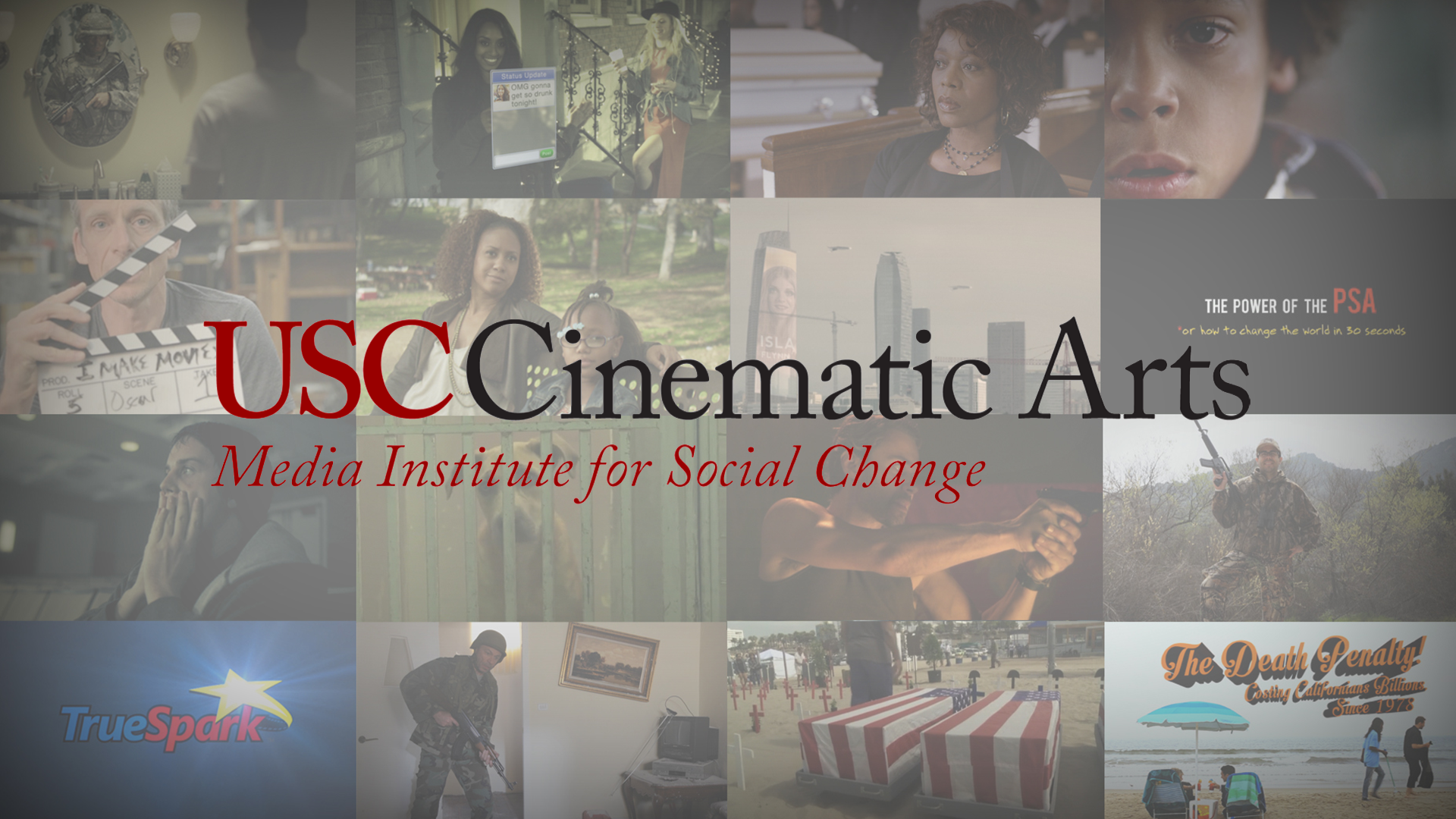
The Media Institute for Social Change, known as MISC, is a production and research institute at the USC School of Cinematic Arts focused on using media as a tool for effecting social change. Founded in 2013 by Michael Taylor, a producer and Professor in the School’s famed Film & Television Production Division, the MISC maxim is that “entertainment can change the world.” It spreads this message by producing illustrative content, and by mentoring student projects, awarding scholarships and leading research. “We are training the next generation of filmmakers to weave social issues into their films, television shows and video games,” says Taylor. “As creators the work we do has a huge impact on our culture and that gives us an opportunity to influence good outcomes.”
In recent years MISC has partnered with organizations including Save the Children, National Institutes of Health and Operation Gratitude, and creative companies like Giorgio Armani, the Motion Picture Association of America and FilmAid, to create groundbreaking work that have important social issues woven into the narrative. MISC also worked with USC’s Keck School of Medicine to create Big Data: Biomedicine a film that shows how crucial big data has become to creating breakthroughs in the medical world. Other MISC films include the upcoming The Interpreter, a short film centered on an Afghan interpreter who is hunted by the Taliban, and The Pamoja Project, the story of 3 Tanzanian women who determined to help their communities by immersing themselves in the worlds of microfinance, health and education. MISC has also partnered with the app KWIPPIT to create emojis that spread social messages. Together they co-hosted the Project Hope L.A. Benefit Concert to spread awareness about the massive uptick of homelessness in Los Angeles.
The Power of the PSA or How to Change the World in 30 Seconds, which documented the institute’s collaboration with the Los Angeles CBS affiliate KCAL9 to make PSAs on gun violence, internet safety, and PTSD among veterans. Another MISC-sponsored film, Lalo’s House, was shot in Haiti with the intention of exposing the child trafficking that is rampant there and in other countries, including the United States. The short film (which is being made into a feature) was used by UNICEF to encourage stricter legislation prohibiting the exploitation of minors, and has won several awards, including a Student Academy Award.
“Our goal,” says Taylor, “is to send our students into the industry with the skills and desire to make entertainment that has positive impact on our culture.” The dream is a variety of mass-media entertainment where social messages aren’t an afterthought but are central to the storytelling.
For more about MISC and its projects, go to uscmisc.org.
Media Impact
Can We Believe The Gillette Ad?
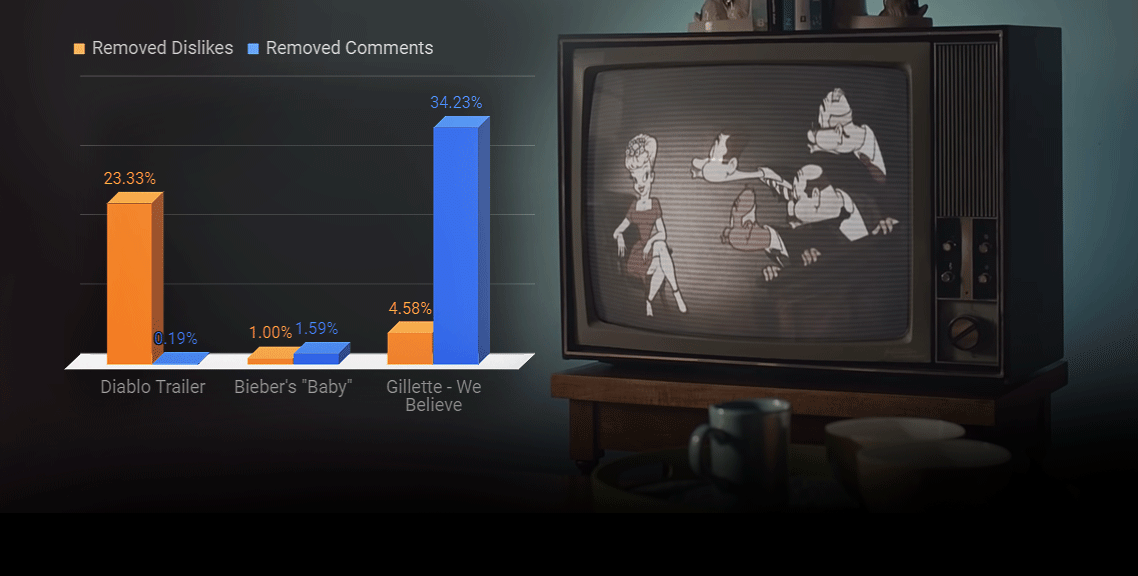
The new Gillette Ad. It’s Pepsi #2. It’s poorly executed, laden with half-hearted strategy, an elephant in the China shop of gender relations.
Numerically speaking, it’s not what it seems to be either. 34% of the ad’s comments were deleted, far more than other videos in similar dislike territories. Gillette’s account might just have set the YouTube proportional record for deleting comments on a single video (the absolute record goes to YT’s own Rewind 2018).
Taking Count – What Numbers Are Real on YouTube?
There have been repeated claims, mostly by YouTube commentators, that dislikes and comments were deleted. Another claim group was that the proportion of likes to dislikes seemed manipulated since it changed from a 10:1 ratio to a 2:1 ratio within days. Some outlets picked up the story, but nobody dove much deeper than a few screenshots. Well, after a few days and 3.000+ measurements we have answers for you.
With the help of YouTube’s API and Archive.fo’s screenshots of the video’s public numbers, we were able to test the claims of whether Gillette’s dislike and comment count were being subject to unusual moderator deletion.
Before we ask that though, it’s important to know how much moderation usually goes on in other controversial videos. If it’s common to delete a certain amount of comments/dislikes, then the criticism of Gillette isn’t directly fair – it’d just be part of the YouTube ecosystem. To get a litmus test of “how common is comment/dislike moderation in similarly controversial videos”, we used a few close neighbors in the List of most disliked YouTube videos as comparables and measured the front-end/back-end discrepancy.
One of them was a “Diablo” game trailer that also received criticism that the publisher had deleted comments and dislikes. Our research was simple – we made API queries to YouTube’s server back-end over the course of a few days while manually transcribing screenshots of the front-end from Archive.fo for similar time spans. While YouTube’s server keeps all video interactions on record, even fraudulent or bot-based ones, the public front-end is influenced by a filtering mechanism that hides certain interactions.
Claim 1: The Gillette Ad Had A Manipulated Growth Pattern
There was nothing really unusual about the growth pattern of likes and dislikes in the Gillette video while we were measuring it. But we started measuring server data on Day 3 of the video being public – the first 3 days we only know from public screenshots, and can project how the deletion pattern must have created a difference.
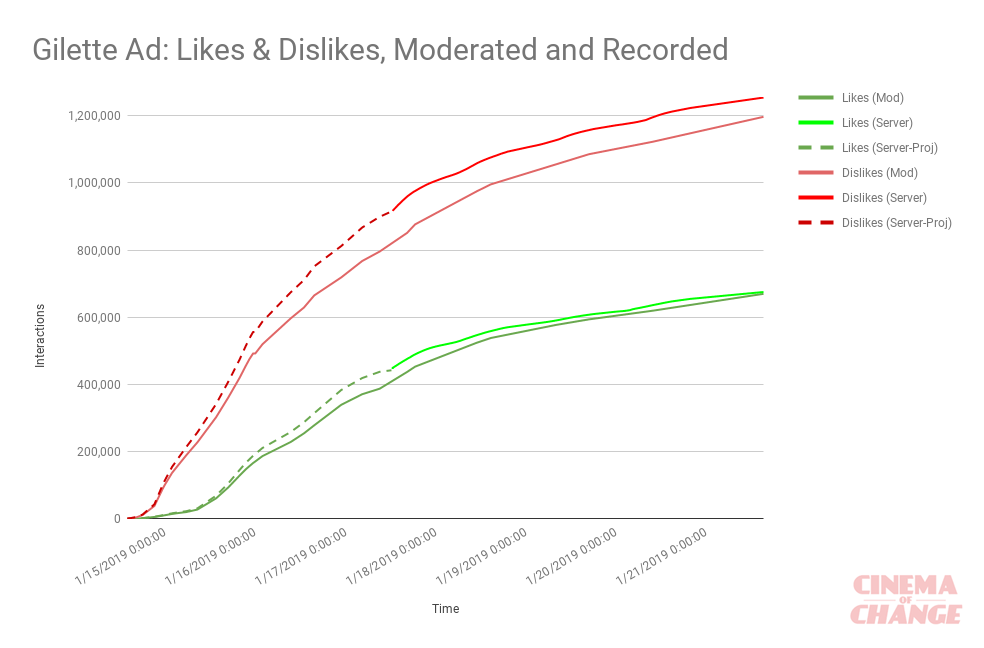
The growth and change of server-side as well as public facing likes and dislikes on the Gillette “We Believe” ad on YouTube.
You can see that in the beginning, dislikes took off very quickly, while likes had a slower growth, but eventually the growth rates approximately equalized, so now there’s a constant 500k lead on dislikes to likes. This is a simple explanation for the changing ratio from 10:1 to 2:1, and we have reason to believe there was no foul play at work there.
Interestingly enough, while there are more dislikes than likes that were hidden by moderators, the likes count disparity shrinks as time goes on, essentially un-hiding likes again. This might be a technical glitch, since a similar shrinkage of hidden dislikes seems to be going on as well.
The archival data only records public likes and dislikes, not comments – so we aren’t sure about the comment deletion pattern over time.
Like data? Take a look at the public spreadsheet.
Claim 2: A High Number of Dislikes and Comments Were Deleted
What was far more surprising to see was the comparison to other highly disliked videos. The server queries resulted in two real outliers – Diablo’s massive deletion of dislikes, and Gillette’s outstanding number of comment deletions. While Blizzard eradicated 220k dislikes on its Diablo Immortal trailer (that’s 23% of the total) from public view (Gillette only deleted 5%, slightly above average), Gillette deleted a whopping 34% of its comments – 172,000 comments to be precise. This is closely followed by YouTube’s own 2018 Rewind video, which has 21% of its comments removed and is the most-disliked video in YouTube history.
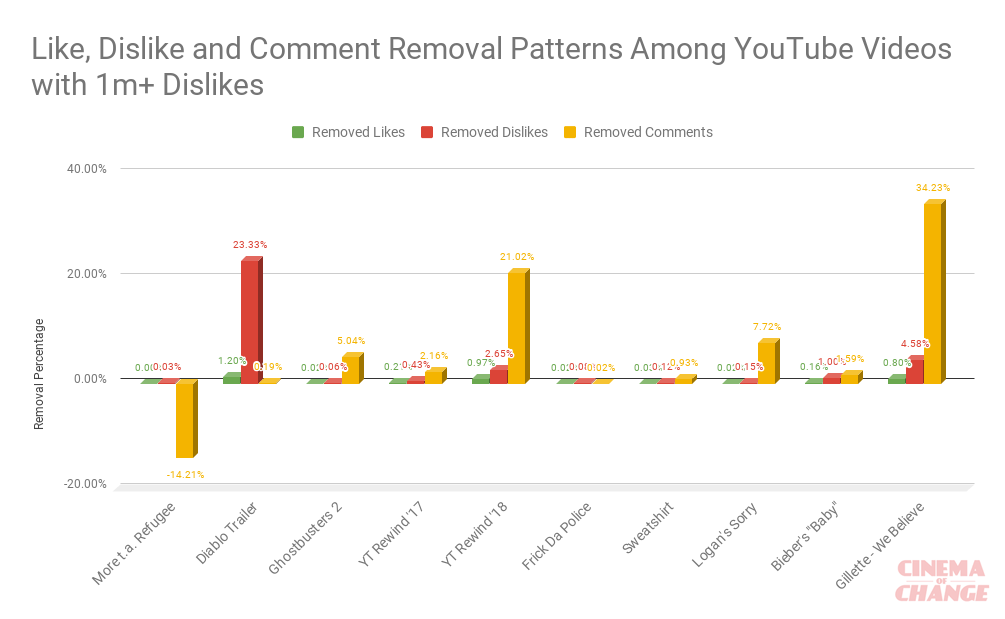
Gillette deleted a potentially historic fraction, 34%, of its comments on the “We Believe” video. Blizzard removed 220,000 dislikes on its worst received game trailer, and YouTube banned 21% of the comments on the latest Rewind video.
Here’s the underlying spreadsheet for that data.
There’s a reasonable argument that the comments on Gillette’s ad were so hateful that they had to be deleted, and the primary fuel to that fire would be the implicit attack on men in general, or the explicitly feminist message. The argument is solid when examining anti-feminist culture on YouTube; Feminist Frequency has their comments and likes disabled since the Gamergate controversy (also on server side), the most-watched pro-Feminist video is a TED Talk and has about 3,000/15% of comments deleted. Then again, semi-viral videos that would fit the “men will feel uncomfortable” category, like the Billie Bodyhair campaign or 10 hours of walking in NYC as a woman or #ustoo PSA, don’t have strong deletion patterns (approx. 1-2%).
If we want to know why Gillette proportionally deleted more comments than anyone else in that league, there’s only one way to know: For Gillette to give the public some insights in what their deletion policies looked like.
Note 1: “More than a Refugee” somehow has more comments publicly displayed than the server-side API query counted – I’m not sure how that’s even technologically possible.
Note 2: After talking with a number of large-channel YouTube managers, I was told that it was not possible to delete dislikes. Well – Blizzard’s 20% dislike deletion shows that YouTube makes exceptions.
Not Just Numbers – Let’s Talk Impact
After analyzing the numbers on YouTube engagements, the question to ask is: How did this happen? Why was the blowback so severe? Gillette was in a unique position to turn the gender relations conversation into a very engaging campaign that would have mobilized people positively. But they didn’t. Instead of focusing on progress, they focused on ambiguous, polarizing messaging.
In short, the “We Believe” ad was a waste of Gillette’s potential. And here is why.
I am all for purpose-driven marketing. I spend day and night thinking about and actually producing impact-driven content. And when that kind of advertising is done right by big agencies, it’s really quite incredible to watch positive impact unfold.
Well-Executed Campaigns as Primers
Take the Kaepernick ad by Nike. It asks people to dare to “dream crazy”, and took a political stance against the oppression of black people in the U.S by featuring Colin. That gamble played out well; the backlash was outweighed by support, and the market responded positively for a good run.
https://www.youtube.com/watch?v=Fq2CvmgoO7I
.
Or remember the Winter Olympics ad, “Proud Sponsor of Moms”? Guess who did that. P&G, parent company of Gillette. Everyone loved that. And in case you don’t watch much advertising, they did more of those, with bold themes and increasingly diverse casting.
P&G followed it up by tastefully celebrating black people’s identity and appearance with “Dear Black Man”:
.
Patagonia didn’t even use a video – they just turned their website dark and said “The President Stole Your Land” as a response to Trump’s threatened shrinkage of National Parks, and then sued him. The market liked it.
There are countless other examples of brands choosing more aware, purpose-driven marketing campaigns.
Watch at least a few of those above to get a primer of “what works”.
What all of them have in common is that they picked an impact area that was either agreeable to most their viewers, or close enough to their company ethos that controversy wouldn’t erode their loyal, primary customer base.
How Not to Do It: Gillette Ad & Pepsi Ad
Now compare this with the below:
Pepsi – “Jump In”:
https://www.youtube.com/watch?v=dA5Yq1DLSmQ
Gillette – “We Believe: The Best Men Can Be”:
https://www.youtube.com/watch?v=koPmuEyP3a0
.
Pepsi co-opted a social movement with a reality TV character and then preached unity when the world looked starkly divided. And even though some Pepsi drinkers might also watch the Kardashians, they saw through the half-hearted charade: Pepsi had nothing to do with activism, period. It was an “out of the blue” decision to capitalize on something happening in the world, and it felt fabricated.
Gillette did the same. Gillette has nothing to do with feminism, or with anti-bullying. Someone at Gillette decided to make this a cause out of the blue.
Gillette co-opted legitimate movements and issues like #metoo, but instead of sheepishly celebrating a soda version of a harsher reality like Pepsi did, it opened with s bad apples as representatives of its core base without delineation, and then sprinkled in a sugar coat of suggestions for all men on how to be better. Nothing new there, it’s just political now.
As a reality check, “toxic masculinity” is a pretty confusing nomer for negative aspects of masculinity. A Gillette ad for women opening with “Abusive women” wouldn’t work just like a US Army ad opening with “Un-patriotic Americans”. The conflation of two words creates ambiguity outside of an academic debate – is the adjective-noun pair describing the quality of the noun, or is it referring to a sub-part of the noun that matches the adjective? To further go into a grey zone, the “toxic” voice over is largely drowned out by “harassment” in the ad, resulting in a “sexual harrassment masculinity” sound upon first listen.
We’re not on a college campus dissecting word pairs here – we are in the world of impact-driven advertising to mass audiences, and you can’t afford ambiguity in this arena. Anyone that looks past these sloppy linguistic choices is providing Gillette a biased playing field.
.
The rest of the video is full of caricatures of bad men mixed with normal men, and an eventual return to “being the best”.
But by then, the base has tuned out, and Gillette has lost. Not only many of their customers, but an opportunity: To actually reshape and contribute to masculinity. To actually make an ad that men will watch, will love, will share, and will actually make them better men. An ad that all men can agree with, without reservations. An ad that doesn’t open with bad apples as representatives. An ad that encourages men to be present in their boys’ lives. A campaign against bullying.
Something that every man can stand behind, and a standard that we’re all proud to live up to. But that chance was wasted for something phony.

Gillette’s skin-tight ads in 2011 remind us of what the brand used to think about women – and how it appealed to similar sentiments it now criticizes, without acknowledging the hypocrisy.
Looking Inward and Forward to Do Better
Why do so few see the charade here?
Gillette could have acknowledged its treatment of women for the past 100 years and apologized, if they wanted to. Nobody really seems to see the irony in applauding to the feminism of the ad and Gillette’s unacknowledged past in contrast.
How about something as complicated as implicit biases by men (like what the boardroom scene tried to address)? Well, they could have done a boy’s version of their Always Ad #LikeAGirl (it’s a bit clunky but the idea is highly effective, and I’m sure it’d have worked with boys too).
All these topics take time and care to implement in separate campaigns. Gillette’s current ad is the impact equivalent of a “YouTube Rewind”, and is heading into similar mashup-dislike-count territory. There have been prior (Harry’s) and later (Egard) attempts to make “men’s issues” themed feel-good ads, but nothing comes close to the “primer” ads on the top, which had an impact edge to them.
A new Adweek Article suggests that the ad was primarily meant for women in the first place, to change their perception of shaving from “disgust” to “joy”. It’s a bit questionable to criticize men as a vehicle to position the brand better for women.
Doing ads that honestly criticize without alienating – that is hard. To Gillette’s credit, they at least failed at something challenging – and that is brave.
Non-Profit Tie-Ins Need Care, Not Just Cash
To finish on a slightly hopeful note – it’s wonderful that Gillette decided to donate $1M to the Boys & Girls Clubs of America. Awesome. But that’s all that Gillette had to say on their new thebestmencanbe.org website. No roll-out, no strategy, no content, no pipeline – just a promise of money and a single link to a great nonprofit. That’s the laziest impact follow-through effort I’ve seen in a long time. Sloppy ad, good nonprofit choice, obvious lack of involvement in the actual impact.
Gillette is a big company, and they can absorb a blow. 1.1M dislikes on YouTube isn’t even close to what Justin Bieber gets. But unlike Gillette, Bieber’s team left the negative comments rather untouched.
.
In the world of purpose-driven advertising, I like to hold companies, agencies and decision-makers to higher standards. Not a peer-pressured applause for intentions, but well-earned respect for nuanced execution and actual impact.
Because we all can be better.
And Gillette should be the best they can be.
Companies
Aging and Nuclear War in the Writers’ Room
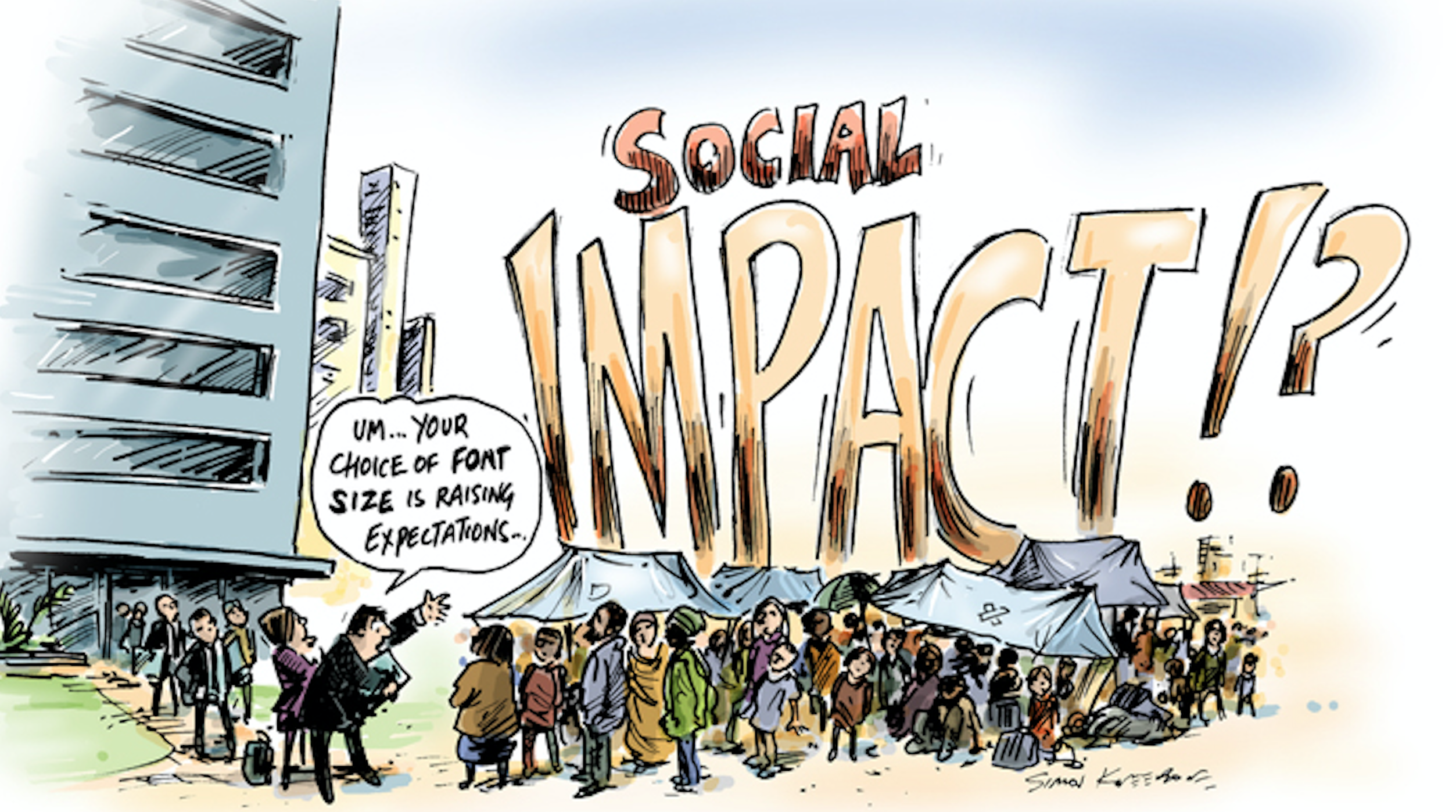
Have you ever heard of Hollywood, Health, & Society? Most likely not.
Yet, you have probably watched something that they have worked on. With over 1,100 aired storylines from 2012-2017 including those for Grey’s Anatomy, NCIS, and black-ish, Hollywood, Health, & Society (HH&S) serves to provide entertainment industry writers with accurate information on storylines related to health, safety, and national security. This pretty much includes everything from aging to nuclear war.
For example, that April 30th, 2017, episode of American Crime that included immigration, opiate abuse, and human trafficking in the plot? Data analysis is currently in progress for a cross-sectional study of viewers.
With the USC Annenberg Norman Lear Center, HH&S not only pairs experts with writers, but also conducts extensive research on their impact and the correlation between seeing things on screen and audiences’ changed perceptions of those topics. HH&S maintains a low public profile, but is very much involved in the writers’ rooms and guilds. Their approach is two-fold:
1) Reactive – responding to requests and needs for HH&S services, which manifests in the form of phone calls and/or emails to the center, expert consultations, guidance on accurate language.
2) Proactive – introducing writers and entertainment professionals to subject matter experts through panel discussions, screenings and immersive events; a quarterly newsletter, tip sheets and impact studies.
Students, you are welcome to use this resource as well! HH&S serves writers at all stages of their careers, although of course, shows on the air or already in production have priority.
To learn more about the research and impact studies behind HH&S:
– Featured list of tip sheets for writers
– CDC’s list of tip sheets from A-Z
– On location trips for writers to gain understanding for certain topics
Follow Hollywood, Health, and Society on Facebook and Twitter to stay updated with their work and upcoming opportunities.
-
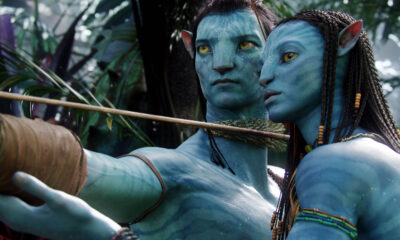
 SIE Magazine10 years ago
SIE Magazine10 years agoWhat Makes A Masterpiece and Blockbuster Work?
-
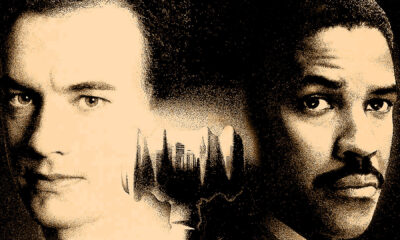
 Filmmakers10 years ago
Filmmakers10 years agoFilms That Changed The World: Philadelphia (1993)
-

 Companies7 years ago
Companies7 years agoSocial Impact Filmmaking: The How-To
-
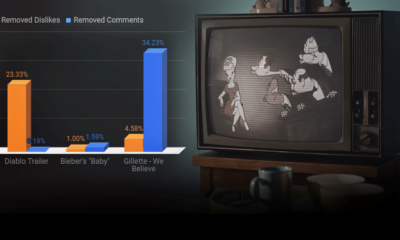
 Media Impact6 years ago
Media Impact6 years agoCan We Believe The Gillette Ad?
-
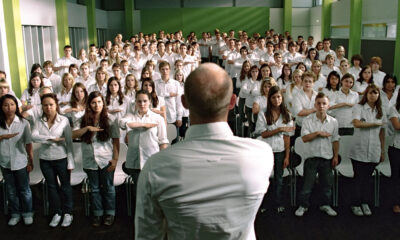
 SIE Magazine10 years ago
SIE Magazine10 years agoDie Welle and Lesson Plan: A Story Told Two Ways
-

 Academia9 years ago
Academia9 years agoFilmmaking Pitfalls in Deal-Making and Distribution
-
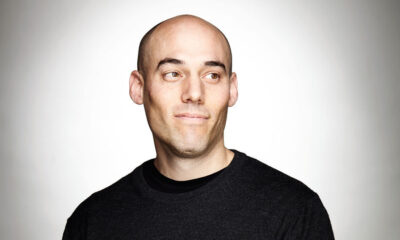
 Academia9 years ago
Academia9 years agoJoshua Oppenheimer: Why Filmmakers Shouldn’t Chase Impact
-
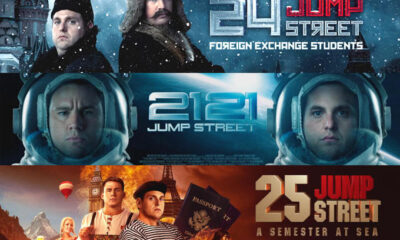
 Filmmakers10 years ago
Filmmakers10 years agoMirror Mirror: An Exploration of Self-Awareness in Recent Hollywood Films



